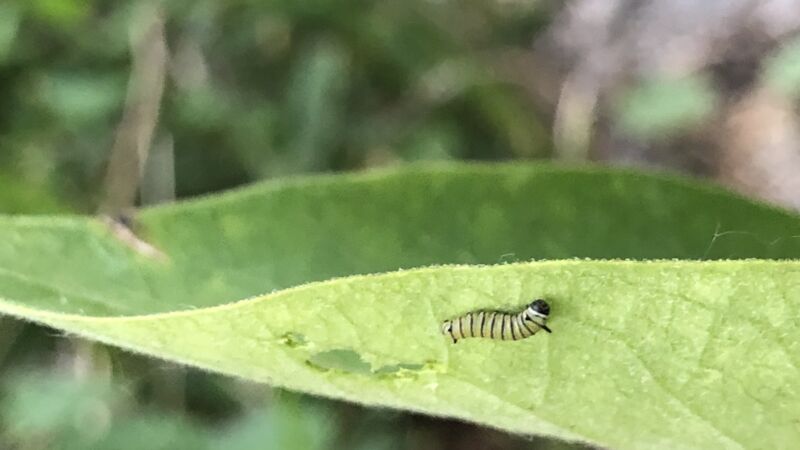
By Rita Morris
This summer I had the pleasure of participating in a monarch community science program, the Monarch Larva Monitoring Project (MLMP). Every week, myself and 1-2 others would go to Falcon Heights Community Park outside of Minneapolis, MN to monitor monarch activity and habitat. This entailed monitoring all the milkweed in the park for monarch eggs and larvae, as well as recording which plants were in bloom. Collecting data for MLMP is a fantastic opportunity to contribute to our scientific knowledge of monarchs, and monitoring in the park was a great way to explore urban monarch habitat and connect with the public about monarch conservation.
The MLMP is a community science program co-run by the Monarch Joint Venture and the University of Wisconsin-Madison Arboretum. This program focuses on collecting long-term data on larval monarch abundance and milkweed habitat. This data on the distribution and abundance of breeding monarchs in North America can be used to inform monarch conservation. So far, MLMP data has been used for 27 publications. Falcon Heights community park has been utilized for MLMP data collection since 2003. In the past 17 years at the park, volunteers have recorded 57,386 milkweed plant observations!
Beyond getting to contribute to science, data collection for the MLMP gave me a reason to closely examine milkweed and other flowering plants. Finding late instar monarch larvae or spotting adult monarchs flying around the site never gets old. In my mind, this was nature showing us that urban milkweed habitat is indeed useful and important for supporting monarch butterflies. But this habitat is valuable for more than just monarchs.
Through my observations in the park, I have gained a deeper appreciation for all of the different insects that depend on milkweed. Although finding a milkweed leaf covered in tussock moth (Euchaetes egle) larvae was a bit of a shock at first! I observed red milkweed beetles (Tetraopes tetrophthalmus), milkweed bugs (Oncopeltus fasciatus), aphids, ants, leafhoppers, bees, and plenty of other arthropods utilizing the milkweed habitat. This just goes to show how valuable monarch habitat is for a diverse array of insects. Here’s a fun fact: monarchs aren’t the only milkweed dwellers who participate in multi-generational migration. Milkweed bugs also migrate annually to escape the cold winter months (Koenig, 2017).
This program gave me the opportunity to speak with community members about monarch conservation and appreciate many other insects in addition to monarchs. I observed many native bees and honey bees using the park’s habitat as well--it was such fun to watch pollinators hard at work! Data collection was also a great way to get me outside and enjoying the Minnesota summer’s beauty. If you are looking for an engaging community science program that gets you out exploring monarch habitat, I highly recommend participating in the MLMP.

Red milkweed beetle (Tetraopes tetrophthalmus) on common milkweed (Asclepias Syriaca).

Milkweed tussock moth (Euchaetes egle) larvae on common milkweed leaf.

Honey bee (Apis mellifera) utilizing common milkweed blooms.

Native bumblebee utilizing wild bergamot (Monarda fistulosa). Wild bergamot is a fragrant native plant that provides nectar for monarchs and other pollinators.

Second instar monarch larva (Danaus plexippus) on common milkweed.

Fourth instar monarch larva on common milkweed.
The Monarch Joint Venture is a national partnership of federal and state agencies, non-governmental organizations, businesses and academic programs working together to conserve the monarch butterfly migration. The content in this article does not necessarily reflect the positions of all Monarch Joint Venture partners. Article and photography by Rita Morris.
Reference:
Koenig, M. (2017). Milkweed dwellers. U.S. Fish and Wildlife Service: Inside Region 3. https://www.fws.gov/midwest/InsideR3/August17Story15.htm
